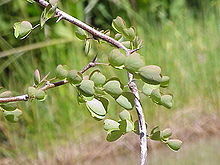
Back خشب البقم Arabic خشب البقم ARZ Haematoxylum campechianum AST Haematoxylum campechianum Catalan Haematoxylum campechianum CEB Kampeškové dřevo Czech Blåtræ Danish Blutholzbaum German Haematoxylum campechianum Spanish بقم Persian
| Haematoxylum campechianum | |
|---|---|

| |
| Scientific classification | |
| Kingdom: | Plantae |
| Clade: | Tracheophytes |
| Clade: | Angiosperms |
| Clade: | Eudicots |
| Clade: | Rosids |
| Order: | Fabales |
| Family: | Fabaceae |
| Subfamily: | Caesalpinioideae |
| Tribe: | Caesalpinieae |
| Genus: | Haematoxylum |
| Species: | H. campechianum
|
| Binomial name | |
| Haematoxylum campechianum L., 1753
| |
| Synonyms | |
| |
Haematoxylum campechianum (blackwood, bloodwood tree, bluewood, campeachy tree, campeachy wood, campeche logwood, campeche wood, Jamaica wood, logwood or logwood tree)[2] is a species of flowering tree in the legume family, Fabaceae, that is native to southern Mexico, and introduced to the Caribbean, northern Central America, and other localities around the world.[3] The tree was of great economic importance from the 17th century to the 19th century, when it was commonly logged and exported to Europe for use in dyeing fabrics.[4] The modern nation of Belize developed from 17th- and 18th-century logging camps established by the English. The tree's scientific name means "bloodwood" (haima being Greek for blood and xylon for wood).
- ^ Bachman, S. (2020). "Haematoxylum campechianum". IUCN Red List of Threatened Species. 2020: e.T62026169A174152099. doi:10.2305/IUCN.UK.2020-2.RLTS.T62026169A174152099.en. Retrieved 19 November 2021.
- ^ Umberto Quattrocchi (2012). CRC World Dictionary of Medicinal and Poisonous Plants. Common Names, Scientific Names, Eponyms, Synonyms and Etymology (5 Volume Set). Boca Raton: CRC Press, Taylor & Francis Group. p. 1919. ISBN 9781420080445.
- ^ "Haematoxylum campechianum". Germplasm Resources Information Network. Agricultural Research Service, United States Department of Agriculture. Retrieved 2009-01-27.
- ^ Hofenk de Graff, Judith H. (2004). The Colourful Past: Origins, Chemistry and Identification of Natural Dyestuffs. London: Archetype Books. p. 235. ISBN 1873132131.
© MMXXIII Rich X Search. We shall prevail. All rights reserved. Rich X Search
